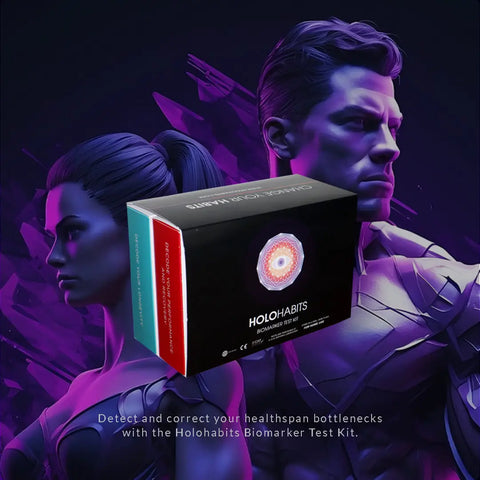In an era where personal health and wellness are at the forefront of our minds, the HoloHabits Biomarker Test Kit emerges as a groundbreaking solution, offering a new level of insight into your health right from the comfort of your home. Initially rooted in elite athlete blood testing, the technology behind HoloHabits has evolved, making in-depth health analysis accessible to everyone.
Introduction
This article explores how the HoloHabits Biomarker Test Kit provides a high-resolution snapshot of what's happening inside your body, analyzing a wide array of nutritional and hormonal biomarkers. To further understand why you need this test, knowing what these markers are and why testing them is vital for evaluating your overall health and well-being is crucial.
Analyzing these nutritional and hormonal biomarkers used to cost thousands of euros just a few years ago. Now you can get the same results and more with a fraction of the cost.
Included Biomarkers
- Amino acids: arginine, citrulline, taurine, tyrosine, asparagine, carnitine, valine, tryptophan, glutamine, proline, threonine, BCAA
- Fatty acids: C18:1 (oleic acid), C18:2 (Linoleic acid), EPA, DHA, Omega-3 index
- Hormones: Testosterone, Cortisol, Testosterone/Cortisol Ratio
- Minerals: Zinc, selenium, magnesium, ferritin, copper, intra-cellular zinc, intra-cellular selenium, intra-cellular magnesium
- Vitamins: D, E, B12 (active), A (retinol)
- Energy & Aging: NAD+ (essential mitochondrial biomarker related to energy metabolism, DNA repair, longevity & aging)
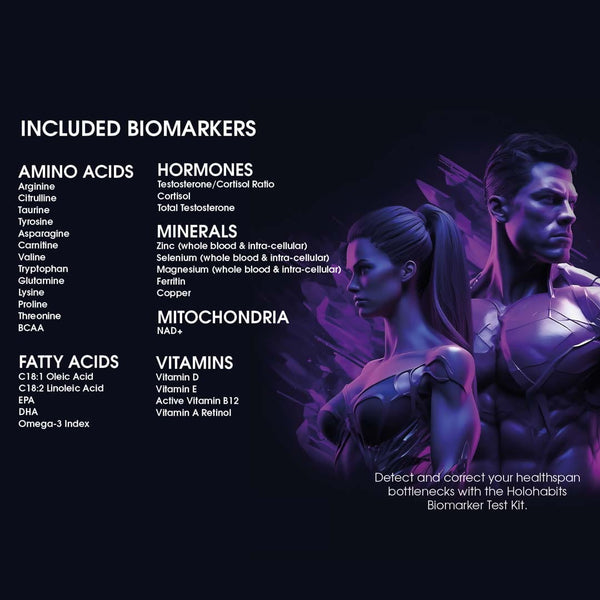
Amino Acids
Amino acids are naturally occurring organic or carbon-containing compounds with an amine group (-NH2) and a carboxyl group (-COOH) as their chemically active parts. About 500 different types of amino acids exist, 240 of which are found in nature. Hence, they are called the building blocks of life. Twenty amino acids are necessary for humans, of which nine are essential (they must be obtained from dietary sources), and the remaining eleven can be synthesized in the body.
The body needs the proteins formed from amino acids to tackle several different tasks. They are as follows:(1)
- Tissue growth and regeneration
- Repair of damaged tissue
- Detoxification
- Food digestion (digestive enzymes)
- Enzymes and cofactors (they catalyze chemical reactions in the body)
- Structural components (in tissues and cell membranes)
- Acceleration and regulation of chemical processes (coenzymes etc.)
- Acting as biological transfer proteins (e.g., hemoglobin)
- Maintaining immune system function (antibodies and immunoglobulins)
- Mediators and signal carriers
- Acting as a hormone
- Ferritin storage
- Energy production
- Cell movement
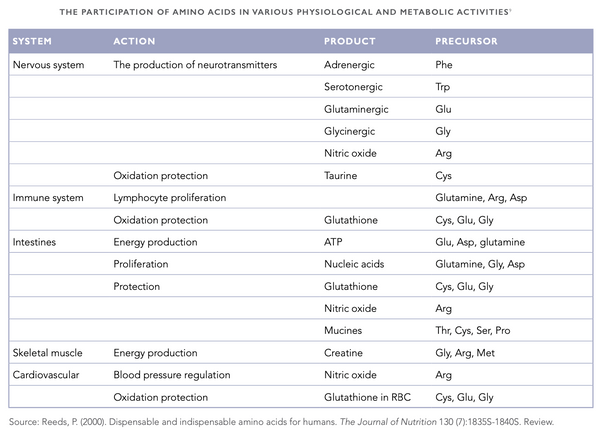
Amino acids measured in the HoloHabits biomarker test kit
Arginine
Arginine is an amino acid that plays a vital role in building protein, wound healing, immune function, and the production of nitric oxide, which is important for blood flow and heart health and is found in foods like meats, dairy, nuts, and legumes.
Asparagine
Asparagine is a non-essential amino acid necessary for brain function and nervous system health, involved in the synthesis of proteins, and found in foods like dairy, beef, poultry, eggs and fish.
BCAA
Branched-chain amino acids (BCAAs), comprising leucine, isoleucine, and valine, are essential nutrients that help build muscle, decrease muscle fatigue, and alleviate muscle soreness, found in protein-rich foods like meat, dairy products, and legumes.
Carnitine
Carnitine, a nutrient synthesized in the body and found in foods like meat and dairy, is essential for transporting fatty acids into mitochondria for energy production, vital for heart and muscle function and beneficial in certain metabolic conditions.
Citrulline
Citrulline is a non-essential amino acid necessary for boosting nitric oxide production, enhancing blood flow, aiding exercise performance, and potentially improving cardiovascular health; it is found in foods like watermelons.
Glutamine
Glutamine, the most abundant amino acid in the body, is vital for immune system function, gut health, and muscle recovery. It is a fuel source for cells, particularly during stress or illness, and is found in meat, eggs, dairy products and certain vegetables.
Proline
Proline is a non-essential amino acid crucial for protein synthesis, wound healing, and collagen production, playing a significant role in maintaining healthy skin, connective tissue, and joint health. It is found in foods like meat, dairy and egg whites.
Taurine
Taurine, a sulfur-containing amino acid found in meat, fish, and dairy, plays a vital role in bile salt formation, eye health, heart function, and brain development and has been shown to have antioxidant properties and benefits for athletic performance.
Threonine
Threonine, an essential amino acid important for protein synthesis, plays a crucial role in collagen and elastin formation, immune function and gut health. It is found in meat, dairy products and certain grains and legumes.
Tryptophan
Tryptophan is an essential amino acid crucial for protein synthesis, serving as a precursor for serotonin (a neurotransmitter) and melatonin (a sleep-regulating hormone), playing a role in mood regulation and sleep. It is found, for example, in turkey, eggs, cheese, and nuts.
Tyrosine
Tyrosine is a non-essential amino acid vital for producing neurotransmitters like dopamine, noradrenaline and adrenaline, influencing mood, cognition, and stress response. It is found in high-protein foods like chicken, turkey, fish, dairy products and nuts.
Valine
Valine, one of the three branched-chain amino acids (BCAAs), is essential for muscle growth, tissue repair, and energy production, playing a critical role in protein metabolism. It is found in meat, dairy, fish, beans and nuts.
Fatty Acids
Fatty acids are chemical compounds consisting of carbon and hydrogen and the carboxyl group, which also contains oxygen. Fatty acids are monocarboxylic acids, which always have an even amount of carbon atoms. In nature, they form carbon chains of various lengths, which determine the class of fatty acids (short-chain fatty acids, medium-chain fatty acids, long-chain fatty acids and very- long-chain fatty acids). Fatty acids can also be either saturated, monounsaturated or polyunsaturated.
Essential fatty acids must be obtained from dietary sources. These are the short-chain omega-3 fatty acids called alpha-linolenic acid (ALA) and the short-chain omega-6 fatty acid called linoleic acid (LA). The human body can produce other fatty acids from essential fatty acids, although this conversion is often not sufficient for optimal nutrition.(2)
Fatty acids affect cell signaling in the body and alter gene expression in fat and carbohydrate metabolism. Moreover, fatty acids may act as ligands for the peroxisome proliferation-activated receptors (PPARs), which play an essential role in the regulation of inflammation (i.e., eicosanoids), fat formation (adipogenesis), insulin and neurological functions, among others.(3)
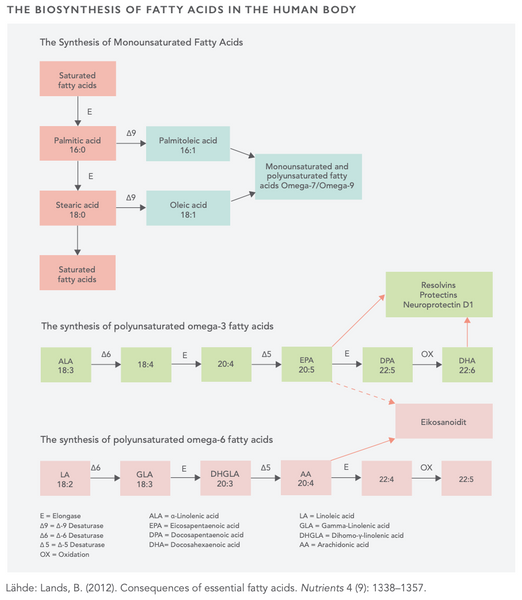
Fatty acids measured in the HoloHabits biomarker test kit
DHA (Docosahexaenoic acid)
Docosahexaenoic acid (DHA) is an omega-3 fatty acid crucial for brain and eye development and supports cardiovascular and brain health. It is predominantly found in fish, seafood, and some algae-based supplements.
EPA (Eicosapentaenoic acid)
Eicosapentaenoic acid (EPA) is an omega-3 fatty acid essential for reducing inflammation, supporting heart health, and potentially improving mental health. It is primarily found in oily fish, seafood, and algae-based supplements.
Linoleic acid
Linoleic acid is an essential omega-6 fatty acid. It is crucial for maintaining the skin's and cell membranes' health, supporting growth and development. It is found in vegetable oils, nuts, seeds and some meats.
Oleic acid
Oleic acid, a monounsaturated omega-9 fatty acid found in olive oil, avocados, and nuts, is beneficial for heart health by improving cholesterol levels reducing inflammation and may also play a role in cancer prevention and insulin sensitivity.
Omega-3 Index
The Omega-3 Index, a measure of the percentage of EPA and DHA omega-3 fatty acids in red blood cell membranes, is a key indicator of heart health, reflecting dietary intake of these essential fatty acids and linked to reduced risks of heart disease and other chronic conditions.
Hormones
Hormones are biologically active molecules synthesized and secreted by specialized glands in the endocrine system. Hormones are critical regulators of physiological functions, interacting with specific receptors in target cells to elicit systemic responses. They operate within a fine-tuned feedback mechanism, maintaining homeostasis across various body systems. Steroid hormones, derived from cholesterol, include sex hormones such as estrogen and testosterone and adrenal cortex hormones like cortisol. Hormonal imbalances, even at minor levels, can lead to significant physiological disruptions, manifesting as various health disorders.(4)

Hormones measured in the HoloHabits biomarker test kit
Cortisol
Cortisol, an essential steroid hormone produced by the adrenal glands, plays a critical role in stress response, metabolism, and immune function and exhibits a natural circadian variation, with levels typically peaking in the morning and declining throughout the day. Ideally, the morning cortisol value should not be too high or too low. The optimal level is around the midway point of the reference range. Significant variation may occur in the morning cortisol values due to stress levels, sleep, exercise and recovery. Most of the cortisol in the blood is bound to carrier proteins – only a small percentage is free and biologically active.(5)
Insufficient cortisol levels suggest that the production triggered by the adrenal glands is affected. Low levels may lead to extreme fatigue, weight loss, muscle weakness and an inability to cope with stress. In athletes, low cortisol levels may lead to burnout, which may happen after continued exercise-induced stress with too little rest over a long period.
Moderately elevated cortisol levels are associated with obesity, various stressful situations (physical and psychological stress, depression, injury, surgery and infections), heavy smoking and alcohol use, during pregnancy and when taking oral contraceptives (estrogens). Cushing's syndrome involves very high cortisol levels.
Symptoms of elevated cortisol levels include fatigue, unexplained muscle loss with increased fat storage and reduced exercise capacity. Reducing the intensity of training and exercise and increasing the number of recovery days at a low intensity should help to reestablish or maintain healthy cortisol levels. Chronically elevated cortisol levels caused by overtraining can lead to chronic catabolic states and burnout.
Total Testosterone
Total testosterone is crucial for developing male sexual characteristics, maintaining muscle mass, bone density, and overall well-being, and its levels are essential indicators of reproductive health, hormonal disorders and age-related changes in both men and women.(6)
Low testosterone levels may occur due to hypothalamus or pituitary gland disease, diabetes, alcoholism, physical testicular injury, malfunction, hyperprolactinemia, or genetic abnormality. Low testosterone levels may cause infertility, low libido, erectile dysfunction, low facial hair growth, reduced muscle mass, and breast enlargement in males (gynecomastia). Low testosterone levels are linked to increased visceral fat, insulin resistance, and a higher risk of cardiovascular diseases.(7)
Testosterone/Cortisol Ratio
The testosterone/cortisol ratio reflects the balance between anabolic (muscle building) and catabolic (muscle breakdown) states in the body, with higher ratios indicating favorable conditions for muscle growth and recovery and lower ratios often associated with overtraining, stress or potential health issues.
The T/C ratio is used as an indicator of the anabolic-catabolic balance in the body. It can reflect the body's response to various stresses, including exercise, psychological stress, and illness. A low T/C ratio (decreased testosterone and/or increased cortisol) might indicate high stress, overtraining or inadequate recovery.(8)
Factors Influencing T/C Ratio:
- Overtraining: Overtraining or excessive physical stress can lead to a decline in the T/C ratio, often signaling fatigue and the need for recovery.
- Sleep: Sleep deprivation or poor sleep quality can alter hormone levels, potentially decreasing the T/C ratio.
- Nutrition: Nutritional status and diet composition can influence testosterone and cortisol levels.
- Psychological Stress: High levels of psychological stress can elevate cortisol levels, which may lead to a decreased T/C ratio.
- Aging: The aging process affects hormone production and secretion, often leading to changes in the T/C ratio
Minerals
Minerals and microelements are naturally occurring inorganic compounds and minerals that are vital for the human body and life. Twelve minerals are essential for human life. Minerals originate from the soil because different living organisms cannot produce them. People get their minerals from plants, which absorb them from the soil. Also, animals receive various minerals from the plants and other animals they eat.(9)
Minerals and microelements are involved in various processes in the human body. These include structural activities in the muscles, skeletal system, nervous system and multiple roles in metabolism. To ensure adequate intake of minerals and microelements, people should eat various animal- and plant-based foods.

Minerals measured in the HoloHabits biomarker test kit
Copper
Copper is an essential trace mineral for forming red blood cells, absorbing iron, functioning immunely, and developing connective tissue and nerve coverings. It is found in liver, shellfish, cashew nuts, dark chocolate and hazelnuts.
Ferritin
Ferritin is not a mineral per se but a protein that stores iron in the body's cells. It is a crucial marker for iron status, with its levels in the blood indicating the total amount of iron available for essential functions like hemoglobin production, and it reflects both iron deficiency and overload.
Magnesium (erythrocytes)
Magnesium, when measured in erythrocytes, reflects the body's cellular magnesium status, essential for muscle and nerve function, bone health, energy production, and blood glucose regulation. It indicates overall magnesium sufficiency or deficiency.
Magnesium (whole blood)
Magnesium levels measured in whole blood provide a comprehensive view of the body's magnesium status, vital for over 300 biochemical reactions, including muscle and nerve function, bone health, energy production and blood pressure regulation.
Selenium (erythrocytes)
Selenium levels measured in erythrocytes accurately reflect the body's long-term selenium status, which is essential for antioxidant defense, thyroid hormone metabolism, immune function, and playing a role in reducing the risk of certain diseases like heart disease and cancer.
Selenium (whole blood)
Selenium levels measured in whole blood offer a comprehensive view of both short-term and long-term selenium status, an essential trace mineral crucial for antioxidant activity, thyroid function, and immune response. The single best dietary source of selenium is brazil nuts.
Zinc (erythrocytes)
Zinc levels in erythrocytes reflect longer-term zinc status due to their 120-day lifespan. Zinc is essential for immune function, wound healing, DNA synthesis, and cell division.
Zinc deficiency can lead to several health issues, such as chronic fatigue, digestive issues and hormonal problems. The most common signs and symptoms associated with zinc deficiency include frequently getting sick, inability to heal wounds, feeling like you're always tired, poor concentration and memory, food cravings for salty or sweet foods, changes in the ability to taste and smell, hair loss, digestive problems and hormonal problems.
Zinc (whole blood)
Zinc levels measured in whole blood comprehensively assess the body's current zinc status, which is crucial for immune response, wound healing, DNA synthesis, and cell division—primary dietary sources for both, including meat, shellfish, legumes and nuts.
Vitamins
Vitamins are organic compounds the body needs to carry out the range of normal physiological functions (as opposed to microelements and minerals, which are inorganic).
Healthy people have a relatively small need for vitamins. However, one might need more vitamins due to stress, silent and chronic inflammatory conditions, long-term illnesses, large intake of medications, smoking, pregnancy and lactation, heavy physical work and various environmental loads (toxins, chemicals, drugs, etc.). Moreover, genetic defects or mutations can prevent vitamin absorption and normal biological utilization of vitamins. The research expertise has shown that today's popular diets taken to extremes can result in micronutrient deficiencies.(10)
There are two types of vitamins based on their absorption into the body: fat-soluble and water-soluble. The way vitamins are dissolved and transported through the body affects their extent of absorption into the body and whether they can be stored in the body's tissues. Apart from vitamin B12, water-soluble vitamins are not very easily stored in the body, whereas fat-soluble vitamins are easily stored in the body's tissues, providing adequate intake and absorption of fatty acids from nutrition. Vitamins A, D, E and K are fat-soluble. Carotenoids are also fat-soluble. Vitamin C and various B vitamins are water-soluble, but vitamins are not chemically or functionally related.
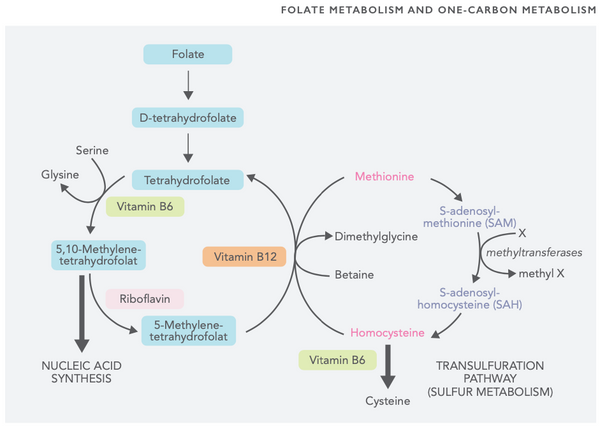
Vitamins measured in the HoloHabits biomarker test kit
Vitamin B12 (active)
Vitamin B12, or cobalamin, is a water-soluble vitamin crucial for red blood cell formation, neurological function, and DNA synthesis, primarily found in animal products and fortified foods.(11)
B12 deficiency is relatively common among vegans. Vitamin B12 deficiency may also occur in people with chronic gastritis (long-term stomach lining inflammation). Left untreated, long-term vitamin B12 deficiency may lead to pernicious anemia or various nervous system disorders (hand numbness, memory problems, problems walking, etc.).(12)
Various inflammatory intestinal diseases and parasites may also cause vitamin B12 deficiency. Usually, the deficiency accrues slowly over time; the liver can store several years' worth of vitamin B12, depending on the previous intake. Some estimates show deficiency symptoms can become apparent after 20–30 years. Such symptoms may include nervous system disorders, fatigue and exhaustion, breathlessness, or symptoms involving mucous membranes. Low levels of vitamin B12 in the body are also linked to depression and the onset of osteoporosis.(13)
Vitamin A
Vitamin A is essential for vision, immune function, and skin health. It has two primary forms: retinol from animal sources like liver and dairy and beta-carotene from plant sources like carrots and leafy greens. Vitamin A can help maintain bone health and immune function and protect the body against oxidative damage.(14)
Low vitamin A levels are associated with infection, bitot's spots, skin irritation, stunted growth, poor wound healing, and muscle soreness.
Vitamin E
Vitamin E is a crucial fat-soluble antioxidant that protects cells from oxidative damage, supports immune health, and is vital for skin and eye health. It is primarily found in nuts, seeds, vegetable oils and leafy green vegetables.(15)
Although vitamin E deficiency is rare, mild deficiency cases might occur with heavy smoking, a bland diet and excessive alcohol consumption. Athletes and other people who do hard physical work and train need higher amounts of vitamin E. Moreover, people who eat large amounts of polyunsaturated fatty acids or have high lipid levels in the blood (cholesterol, etc.) need higher amounts of vitamin E.
Total Vitamin D
Total Vitamin D, measured in blood tests, includes D2 and D3 forms and is essential for bone health, calcium absorption, and immune function. Sun exposure, diet and supplements influence its levels in the body, which is crucial for overall health and disease prevention.(16)
Vitamin D deficiency is common and can lead to a loss of bone density, which can contribute to osteoporosis and fractures (broken bones). In children, it can cause rickets, a rare disease that causes the bones to become soft and bend.
Vitamin D deficiency has been linked to (among other things) cardiovascular disorders, different cancers, multiple sclerosis (MS), rheumatic diseases, metabolic syndrome, fibromyalgia, depression, various neurological disorders, infectious diseases and even mortality.
A study by the University of Cambridge in 2014 showed that human mortality was the lowest when vitamin D levels in the blood (calcitriol) were at least 90 nmol/l (36 ng/mL). A higher concentration of vitamin D in blood did not affect human mortality in any way.(17)
Few foods are naturally rich in vitamin D. Vitamin D includes fatty fish (trout, salmon, herring, mackerel, sardine) and fish liver oils. Smaller amounts are found in organ meat (e.g. beef liver), mushrooms (e.g. maitake, chanterelle, morel), egg yolks and fortified foods (such as fortified milk).
Aging and Energy Production
At the cellular metabolic level, mitochondria determine the links between energy production and aging. As we age, the capability of mitochondria to transform nutrients into adenosine triphosphate (ATP)-the primary energy currency usually wanes. The reduced mitochondria bioenergetics result in increased oxidative stress and accumulation of mtDNA mutations related to lower energy production. This energy deficit decreases the ability to repair, grow and adapt to physiological declines due to aging-specific impacting forces.(18)
NAD+ levels also decrease with age, reducing mitochondrial efficiency and increasing oxidative stress, resulting in cellular damage and less energy production. It is now believed that this age-associated NAD+ depletion is a key determinant of aging.(19)
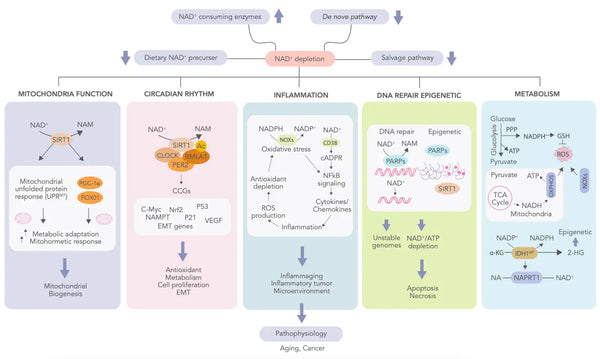
NAD+
NAD+ (Nicotinamide Adenine Dinucleotide) is a critical coenzyme in cellular energy metabolism, DNA repair and cell signaling, playing a pivotal role in aging and multiple metabolic processes, including those in the brain, heart and muscles.
To increase NAD+ levels in cells, a combination of dietary, lifestyle, and supplemental approaches can be effective. Incorporating foods rich in NAD+ precursors, such as dairy, fish, mushrooms, and green vegetables, is fundamental. Regular exercise, particularly high-intensity interval training (HIIT), has been shown to boost NAD+ levels due to its impact on cellular metabolism. Caloric restriction or intermittent fasting can also stimulate NAD+ production by activating specific pathways involved in energy metabolism.(20)
Additionally, supplements like Niacinamide, Nicotinamide Riboside (NR) or Nicotinamide Mononucleotide (NMN), precursors to NAD+, can directly increase NAD+ synthesis. Herbal supplements such as green tea extract, turmeric, parsley and resveratrol, which influence various enzymes and pathways related to NAD+ metabolism, can also be beneficial.(21)
Conclusion
HoloHabits Biomarker Test Kit provides a high-resolution snapshot of what's happening inside your body, analyzing various nutritional and hormonal biomarkers. From the convenience of an at-home blood test to the detailed, easy-to-understand results delivered directly to your device, HoloHabits is not just about testing; it's about offering actionable insights and personalized recommendations to enhance your health. Whether you're looking to address nutrient deficiencies, improve your physical performance, or better understand your body's needs, the HoloHabits Biomarker Test Kit is your ally in the journey toward optimal health and longevity.
Order your test kit now!
Download the free Holohabits App here.
Scientific References:
- Alberts B, Johnson A, Lewis J, et al. Molecular Biology of the Cell. 4th edition. New York: Garland Science; 2002. Protein Function.
- Lands, B. (2012). Consequences of essential fatty acids. Nutrients 4 (9): 1338–1357.
- Institute of Medicine (2005). Dietary Reference Intakes for Energy, Carbohydrate, Fiber, Fat, Fatty Acids, Cholesterol, Protein, and Amino Acids. Chapter 8: Dietary Fats: Total Fat & Fatty Acids. Washington, DC: The National Academies Press.
- Bhagavan, N., & Ha, C. (2011). Endocrine Metabolism I: Introduction and Signal Transduction1. , 383-395.
- Weitzman, E. D., Fukushima, D., Nogeire, C., Roffwarg, H., Gallagher, T. F., & Hellman, L. (1971). Twenty-four hour pattern of the episodic secretion of cortisol in normal subjects. The Journal of Clinical Endocrinology & Metabolism, 33(1), 14-22.
- Laughlin, G. A., Barrett-Connor, E., & Bergstrom, J. (2008). Low serum testosterone and mortality in older men. The Journal of Clinical Endocrinology & Metabolism, 93(1), 68-75.
- Livingston, M., Kalansooriya, A., Hartland, A. J., Ramachandran, S., & Heald, A. (2017). Serum testosterone levels in male hypogonadism: Why and when to check—A review. International journal of clinical practice, 71(11), e12995.
- Greenham, G., Buckley, J. D., Garrett, J., Eston, R., & Norton, K. (2018). Biomarkers of physiological responses to periods of intensified, non-resistance-based exercise training in well-trained male athletes: a systematic review and meta-analysis. Sports medicine, 48, 2517-2548.
- National Research Council (US) Committee on Diet and Health (1989). Diet and Health: Implications for Reducing Chronic Disease Risk. Chapter 14, Trace Elements. Washington, DC: National Academies Press (US).
- Calton, J. (2010). Prevalence of micronutrient deficiency in popular diet plans. Journal of the International Society of Sports Nutrition 7 (1): 1–9.
- O’Leary, F. & Samman, S. (2010). Vitamin B12 in health and disease. Nutrients 2 (3): 299–316.
- Kozyraki, R. & Cases, O. (2013). Vitamin B12 absorption: mammalian physiology and acquired and inherited disorders. Biochimie 95 (5): 1002–1007.
- Loikas, S. et al. (2007). Vitamin B12 deficiency in the aged: a population-based study. Age and Ageing 36 (2): 177–183.
- Higdon, J. & Tan, L. (2015). Vitamin A. The Linus Pauling Institute’s Micronutrient Information Center (MIC).
- Ahsan, H. & Ahad, A. & Iqbal, J. & Siddiqui, W. (2014). Pharmacological potential of tocotrienols: a review. Nutrition & Metabolism 11 (1): 1–22.
- Mak, J. (2019). An Evidence-Based Review of Efficacy and Safety of Dietary, Natural Supplements and Sunlight in Vitamin D Deficiency. Vitamin D Deficiency, 95.
- Khaw, K. & Luben, R. & Wareham, N. (2014). Serum 25-hydroxyvitamin D, mortality, and incident cardiovascular disease, respiratory disease, cancers, and fractures: a 13-y prospective population study. The American Journal of Clinical Nutrition 100 (5): 1361–1370.
- Akbari, M., Kirkwood, T. B., & Bohr, V. A. (2019). Mitochondria in the signaling pathways that control longevity and health span. Ageing research reviews, 54, 100940.
- Xie, N. et al. (2020). NAD+ metabolism: pathophysiologic mechanisms and therapeutic potential. Signal Transduction and Targeted Therapy 5 (1): 1-37.
- Poljsak, B. & Kovač, V. & Milisav, I. (2020). Healthy Lifestyle Recommendations: Do the Beneficial Effects Originate from NAD+ Amount at the Cellular Level? Oxidative Medicine and Cellular Longevity 2020: 8819627.
- Conlon, N., & Ford, D. (2022). A systems-approach to NAD+ restoration. Biochemical pharmacology, 198, 114946.





